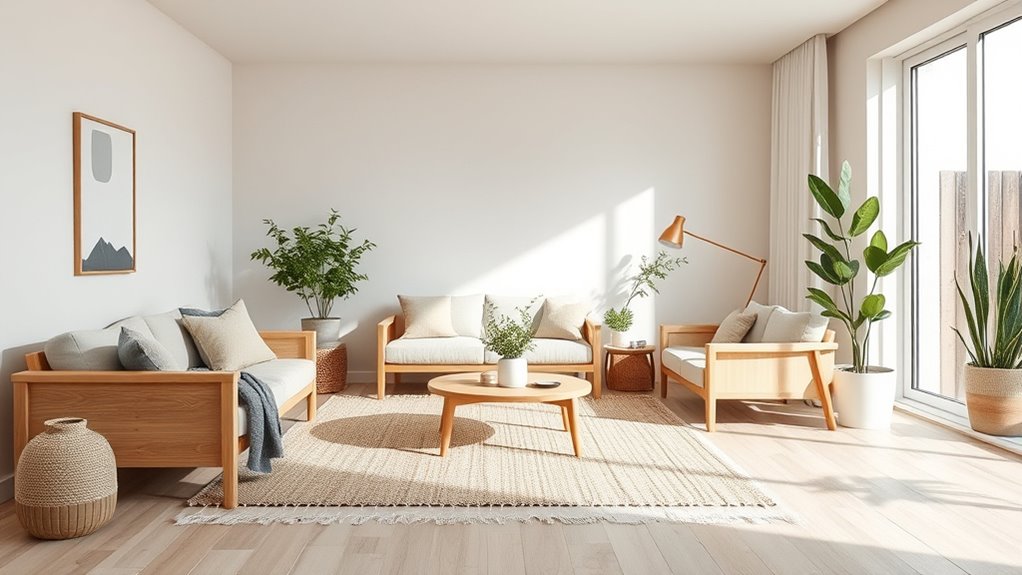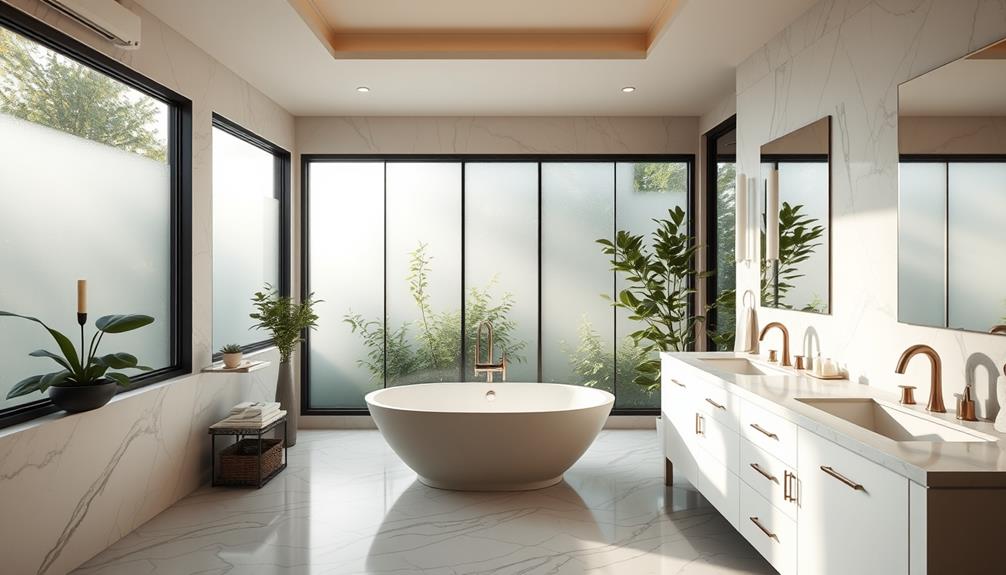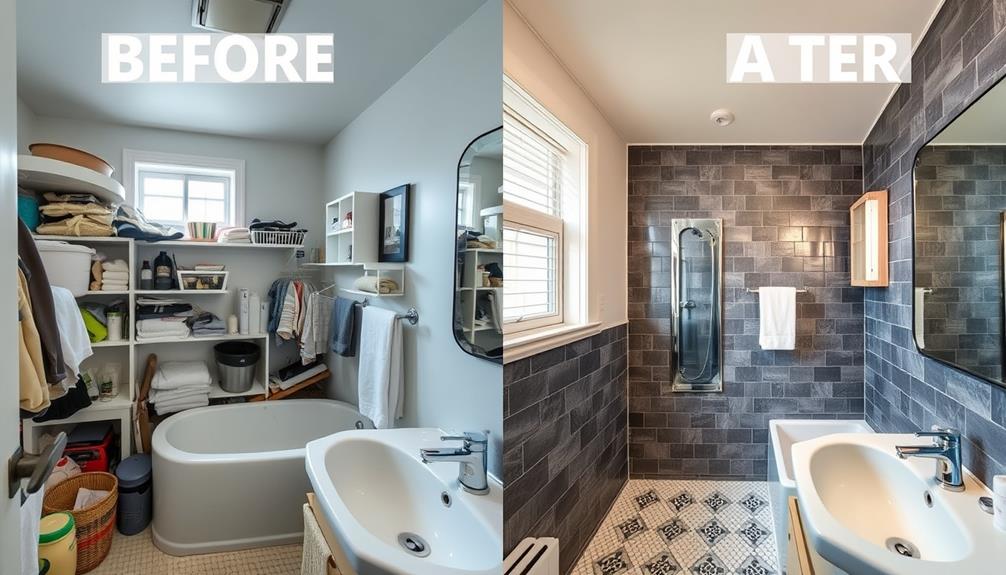Japandi blends Japanese minimalism with Scandinavian coziness to create calm, functional spaces. It emphasizes natural materials, neutral colors, and simple, clean lines to promote serenity and balance. This style combines cultural values of imperfection and warmth, shaping environments that feel both peaceful and practical. By focusing on simplicity, natural textures, and mindful design, you can achieve a stylish, harmonious home. If you explore further, you’ll discover how to bring this tranquil aesthetic into your space with ease.
Key Takeaways
- Japandi combines Japanese minimalism’s simplicity with Scandinavian coziness, emphasizing natural materials and balanced design.
- It focuses on creating tranquil, clutter-free spaces that promote calmness and mindfulness.
- The style uses neutral color palettes and organic textures to foster serenity and warmth.
- Functional furniture with clean lines and eco-friendly materials reflects both cultures’ practicality and sustainability.
- Japandi promotes harmony by blending form, function, and natural elements for a balanced living environment.
The Origins and Cultural Influences Behind Japandi
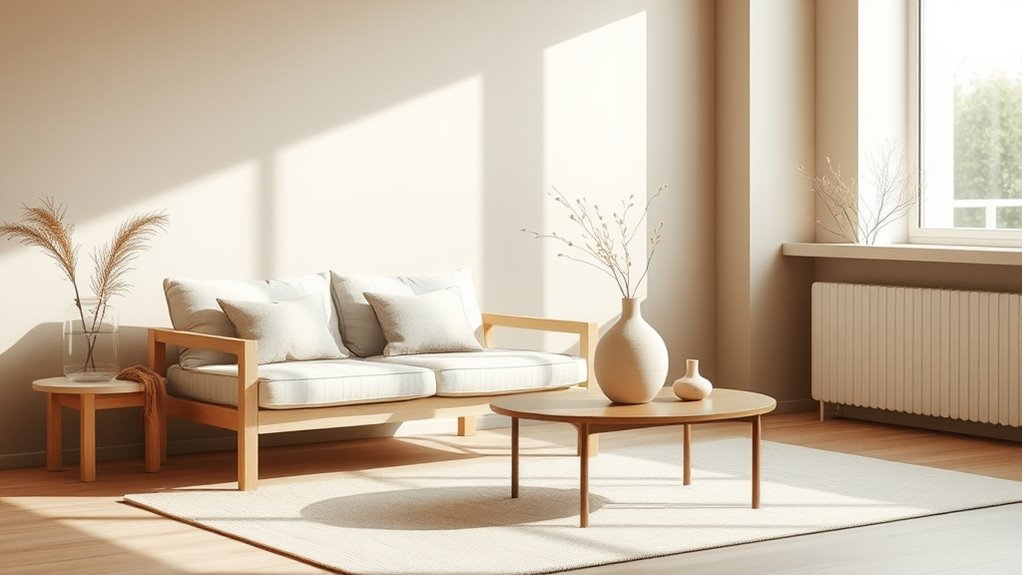
Japandi blends the minimalist elegance of Japanese design with the cozy simplicity of Scandinavian aesthetics, creating a harmonious fusion rooted in cultural history. The Japanese origins draw from the Wabi Sabi philosophy, emphasizing beauty in imperfection and transience, encouraging you to appreciate simplicity and natural materials. Japanese minimalism values functionality, clean lines, and uncluttered spaces, shaping the foundation of Japandi’s aesthetic. Meanwhile, Scandinavian influences focus on warmth, comfort, and practicality, fostering a sense of calm and coziness. Together, these cultures merge their core values to form a style that’s both serene and inviting. An understanding of Cultural Intelligence highlights the importance of maintaining harmony and balance in interior design, reflecting Japandi’s emphasis on natural elements and understated elegance. Additionally, incorporating cultural influences ensures a respectful and authentic representation of each tradition within modern interiors.
Core Principles of Japandi Design
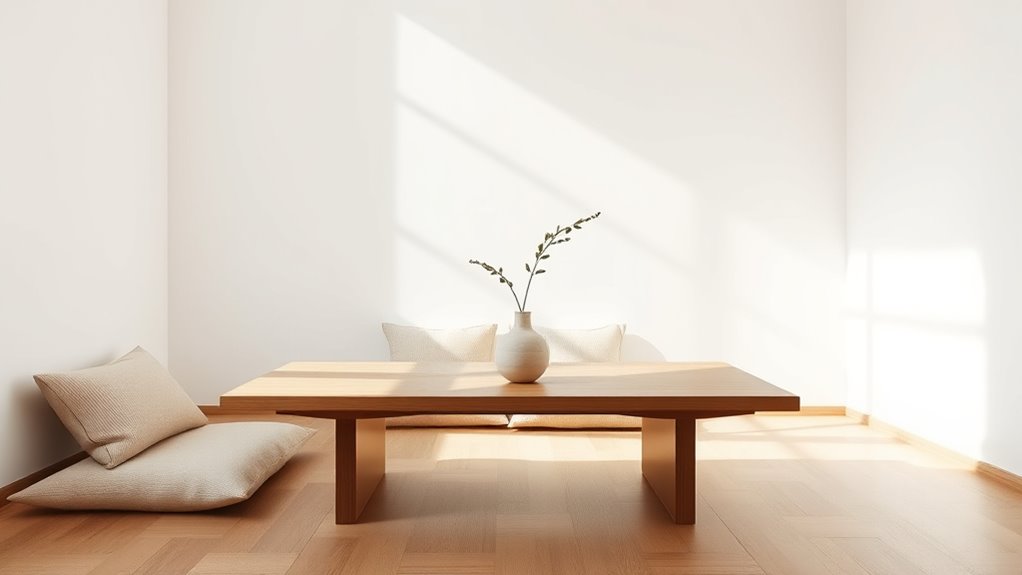
At the heart of Japandi design lies a commitment to simplicity and balance, where every element serves a purpose. You focus on creating a space that exudes zen tranquility, encouraging calm and mindfulness. Modern minimalism is key, so clutter is minimized, and clean lines dominate. The design emphasizes natural materials like wood, stone, and linen, fostering warmth and texture. Neutral color palettes reinforce serenity, allowing you to feel at ease. Functionality is prioritized without sacrificing aesthetics, ensuring each piece adds value. The core principles guide you to blend form and function seamlessly, producing an environment that feels both peaceful and stylish. Ultimately, Japandi promotes a mindful approach to living, where simplicity fosters clarity and harmony in your space.
Key Elements and Aesthetic Features
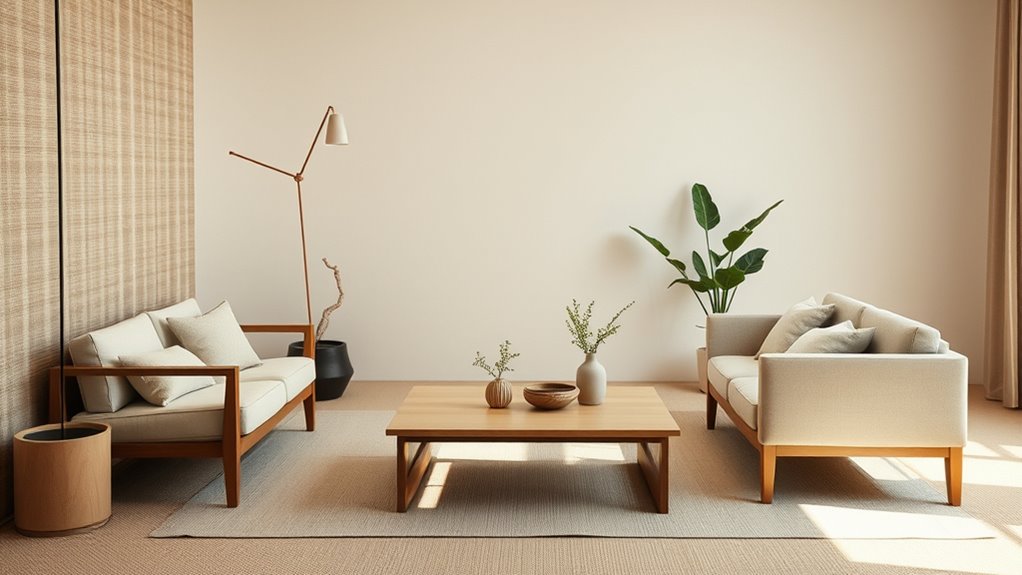
You’ll notice that Japandi design emphasizes minimalist simplicity and clean, functional forms. Natural materials and textures bring warmth and authenticity, while neutral color palettes create calm and harmony. Together, these elements define the tranquil, refined aesthetic that characterizes Japandi style. Additionally, incorporating emotional support principles can enhance the sense of wellbeing and comfort in a Japandi-inspired space. Understanding the importance of design psychology can help in creating environments that promote relaxation and mental clarity. Recognizing the role of intentional simplicity can further deepen the connection between form and function, fostering a serene atmosphere.
Minimalist Simplicity and Form
The essence of Japandi design lies in its commitment to minimalist simplicity, emphasizing clean lines and uncluttered spaces. You’ll notice that decorative accents are kept subtle, serving as focal points rather than distractions. You can also see how natural materials are integral to creating a cohesive and harmonious environment, reflecting the appreciation for craftsmanship and authenticity. The form of furniture is streamlined, with functional shapes that blend beauty and utility effortlessly. Lighting design plays a vital role, using simple fixtures that cast soft, warm light to enhance the calm atmosphere. Every element is intentional, avoiding excess and emphasizing form over ornamentation. This approach creates a sense of tranquility, allowing each piece to stand out quietly. In Japandi, simplicity isn’t about austerity but about highlighting the natural elegance of well-chosen elements through restraint and clarity. Incorporating unique and wicked planters can further enhance the aesthetic by adding subtle personality while maintaining the overall harmony. Additionally, mindful decluttering strategies ensure that spaces remain serene and functional, reinforcing the minimalist philosophy.
Natural Materials and Textures
What gives Japandi its warm, inviting feel are the natural materials and textures that define its aesthetic. You’ll notice the use of organic textures like wood, stone, and bamboo, which bring a sense of nature indoors. Woven textiles add depth and coziness, often seen in rugs, throws, and cushions made from linen or wool. These elements create a tactile experience, balancing sleek lines with tactile warmth. To help visualize, here’s a quick comparison:
| Material | Texture Type |
|---|---|
| Hardwood floors | Smooth, natural grain |
| Rattan furniture | Woven, tactile |
| Linen curtains | Soft, organic feel |
| Stone accents | Rough, earthy |
| Wool throws | Cozy, textured |
These natural elements are key to achieving the serene, harmonious look of Japandi. Incorporating sustainable design principles can further enhance the eco-friendly appeal of this style.
Neutral Color Palettes
Neutral color palettes are fundamental to achieving the calm, balanced look of Japandi design. They create a serene backdrop that emphasizes simplicity and harmony. Soft beiges, warm greys, and muted whites form the foundation, allowing other elements to stand out. To add personality, incorporate vibrant accents—think cushions, vases, or art—in bold patterns or striking colors. These pops of vibrancy prevent the space from feeling dull, while still maintaining the minimalist aesthetic. The key is balancing subtle, neutral tones with carefully chosen vibrant accents or bold patterns to create visual interest without overwhelming the calm atmosphere. Additionally, understanding scam avoidance practices can help ensure that your investment decisions, whether in design elements or financial products, are secure and well-informed. This approach ensures your space remains both inviting and uncluttered, embodying the essence of Japandi’s understated elegance.
Natural Materials and Color Palette Choices
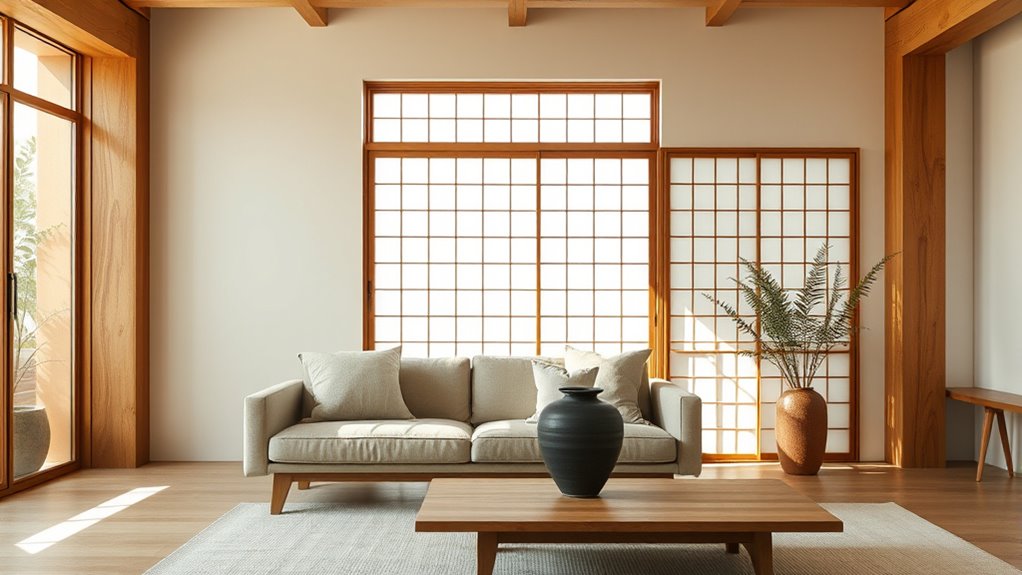
Japandi design emphasizes the use of natural materials and a subdued color palette to create a calming, harmonious space. You’ll find that materials like wood, bamboo, and linen dominate, bringing warmth and texture to your environment. These natural elements are often paired with simple, clean lines to maintain a minimalist aesthetic. When choosing textile patterns, opt for subtle textures and understated designs that add visual interest without overpowering the space. Decorative accents, such as ceramic vases or woven baskets, echo the natural theme and reinforce the tranquil vibe. Stick to earthy tones like beige, taupe, and muted greys, which blend seamlessly with the natural materials. This combination fosters serenity and balance, making your space feel inviting yet uncluttered. Incorporating natural materials can also enhance eco-friendly interior choices that complement the natural aesthetic, aligning with sustainable design principles.
Incorporating Japandi Into Your Living Space
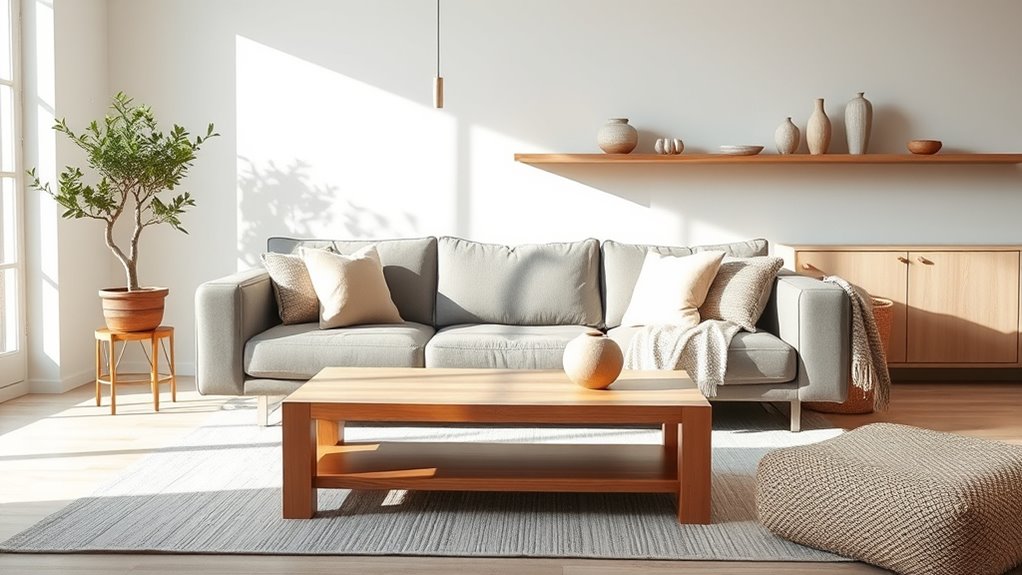
To incorporate Japandi into your living space, start with a neutral color palette that creates a calm atmosphere. Choose minimalist furniture with clean lines to keep the look simple and functional. Finally, add natural elements like wood or plants to bring warmth and a touch of nature indoors. Incorporating cultural sensitivity can further enhance the harmonious blend of Japanese and Scandinavian aesthetics, creating a space that reflects both traditions. Paying attention to nutritional advantages of green juice can inspire incorporate healthful, vibrant touches into your decor, such as botanical prints or plant-based accents, emphasizing a balanced and mindful lifestyle. Developing adaptability in your design approach allows you to effortlessly update or modify your space as your tastes evolve over time.
Choosing Neutral Color Palette
When incorporating Japandi style into your living space, selecting a neutral color palette creates a calm and harmonious environment. Neutral tones like beige, soft gray, and warm whites promote color harmony, making your space feel balanced and inviting. These hues set the mood for relaxation and simplicity, essential to Japandi’s aesthetic. To help visualize, consider this table:
| Warm Neutrals | Cool Neutrals |
|---|---|
| Beige | Light Gray |
| Taupe | Charcoal |
| Cream | Steel Blue |
| Soft White | Slate Gray |
| Sand | Dusty Blue |
Choosing the right shades influences mood setting, enhancing tranquility and understated elegance in your home. Focus on subtle contrast and natural light to amplify the serene atmosphere Japandi embodies.
Selecting Minimalist Furniture
Selecting minimalist furniture is essential to achieving the clean, uncluttered look that defines Japandi style. Focus on pieces with simple lines and functional design, emphasizing quality over quantity. Incorporate sustainable furniture crafted from eco-friendly materials to align with Japandi’s emphasis on sustainability. Look for versatile, timeless pieces that blend seamlessly into your space. Vintage decor can add warmth and character, making your environment feel inviting without cluttering it. When choosing furniture, prioritize neutral tones and natural finishes, which complement your color palette. Keep surfaces free of excess accessories, allowing the furniture’s form and material to stand out. This approach creates a calm, balanced atmosphere that embodies the essence of Japandi design. Additionally, understanding potential pitfalls in adopting new payment technologies can help avoid unexpected challenges in your home or business setup. Support hours for furniture stores or showrooms may vary, so checking store availability can help ensure your shopping experience is smooth.
Incorporating Natural Elements
Incorporating natural elements into your living space is a cornerstone of Japandi design, bringing a sense of tranquility and harmony. You can start by adding indoor plants through urban gardening, which not only enhances the aesthetic but also improves air quality. Use decorative accents like wooden bowls, stone sculptures, or woven baskets to introduce organic textures and warmth. Natural materials such as linen, cotton, and jute for cushions and curtains keep the space feeling fresh and inviting. Keep the arrangement simple and uncluttered, allowing the natural elements to stand out. This connection to nature fosters calmness and balance, essential to the Japandi style. Additionally, utilizing Natural materials in furniture and accessories further emphasizes the organic, eco-friendly aesthetic. By thoughtfully integrating these natural touches, you create a serene environment that reflects both Japanese minimalism and Scandinavian coziness.
Benefits of Embracing Japandi Style
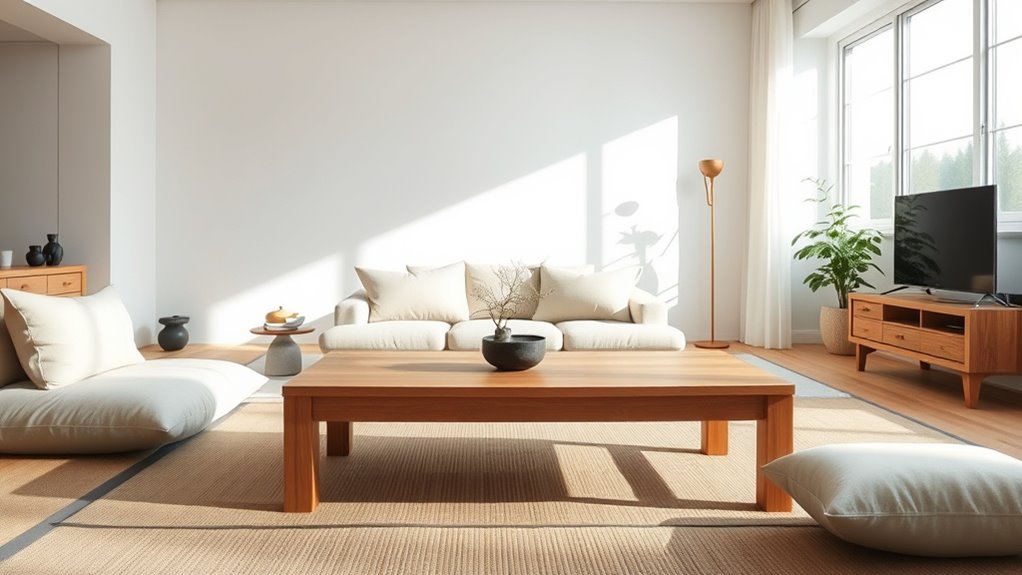
Embracing Japandi style offers a harmonious blend of simplicity and elegance that can transform your living space. It promotes sustainable living by encouraging minimalism and mindful choices, reducing clutter and waste. This aesthetic also emphasizes modern functionality, ensuring your environment is both beautiful and practical. With clean lines and neutral tones, Japandi creates a calming atmosphere that enhances focus and relaxation. Adopting this style can make your home more efficient and environmentally friendly, aligning with eco-conscious values. Additionally, Japandi’s focus on biophilic design fosters a stronger connection to nature within indoor spaces. The trend’s emphasis on mindful living encourages intentional choices that support well-being and sustainability. As the trend continues to grow, it reflects a broader movement towards sustainable interior design choices.
Tips for Achieving Balance and Simplicity
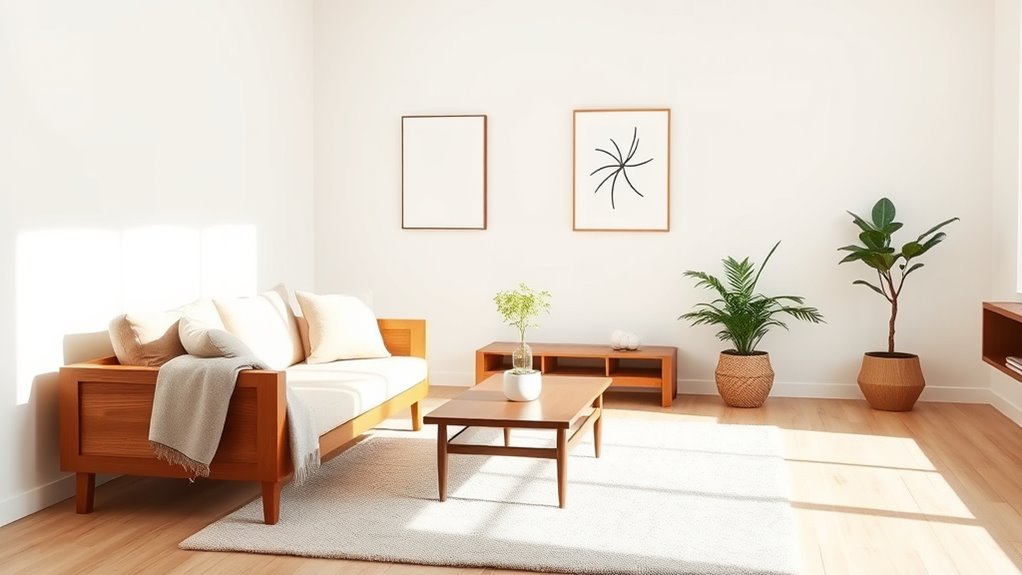
Achieving balance and simplicity in your space requires intentional choices that prioritize harmony and functionality. Start by incorporating zen gardens or minimalist plant arrangements to create a calming focal point, emphasizing natural elements. Keep clutter to a minimum, allowing each piece to breathe and serve a purpose. Use seasonal decor thoughtfully, swapping out accents to reflect the changing seasons without overwhelming the space. Stick to a neutral color palette with subtle accents for visual interest. Select furniture with clean lines and simple designs that blend form and function seamlessly. Remember, less is more—focus on quality over quantity, and maintain a sense of order. These tips help foster a serene environment rooted in balance, making your space a true reflection of Japandi’s essence. Additionally, consider the store hours of your favorite beauty retailers to plan your shopping trips efficiently.
Frequently Asked Questions
How Does Japandi Differ From Other Minimalist Interior Styles?
You notice that Japandi differs from other minimalist styles through its balanced blend of Japanese simplicity and Scandinavian warmth. Unlike the stark contrast with Wabi Sabi, Japandi embraces imperfections with subtlety. It also fuses with shabby chic by adding cozy, lived-in elements. This style emphasizes functionality, natural materials, and calm aesthetics, creating a serene space that’s more inviting and harmonious than typical minimalist designs.
Can Japandi Design Suit Small or Urban Living Spaces?
It’s no coincidence that Japandi works beautifully in compact spaces and urban living environments. You’ll find that its clean lines, natural materials, and calming aesthetics maximize your small area’s potential without clutter. By blending simplicity with warmth, Japandi creates a serene retreat amid city chaos. Its minimalist approach makes your urban space feel more open, functional, and inviting, proving that less truly is more in tight quarters.
What Are Common Misconceptions About Japandi Aesthetics?
You might think japandi aesthetics are overly simplistic or cold, but that’s a misconception. It’s a minimalist approach that emphasizes warmth and functionality through cultural fusion, blending Japanese serenity with Scandinavian coziness. People often assume it’s only for modern spaces, but it works beautifully in cozy or traditional settings too. In reality, japandi creates a balanced, inviting atmosphere that highlights simplicity without sacrificing comfort.
Is Japandi Suitable for Both Modern and Traditional Homes?
You might wonder if Japandi fits both modern and traditional homes. The good news is, it’s versatile because of its furniture compatibility and neutral color palette choices. Modern homes benefit from sleek lines, while traditional spaces can be softened with warm textures. By blending these elements thoughtfully, you can create a harmonious Japandi aesthetic that complements any home style seamlessly.
How Sustainable Is Japandi Design in Terms of Material Sourcing?
Imagine building a house with bricks that grow naturally around you—that’s what sustainable material sourcing offers. Japandi design embraces eco-friendly practices, using materials like reclaimed wood and natural fibers. This approach makes it highly sustainable, reducing environmental impact and promoting eco-conscious living. By choosing these materials, you support a design trend that’s both beautiful and responsible, aligning your space with nature’s harmony.
Conclusion
As you embrace Japandi, you realize it’s more than just a style—it’s a way to find harmony in everyday living. Sometimes, the simplest choices, like a clean line or a natural material, reveal a deeper balance within. It’s no coincidence that this blend of Japanese serenity and Scandinavian warmth encourages you to create a space that feels truly yours. In embracing Japandi, you discover that simplicity often leads to the most profound sense of peace.
